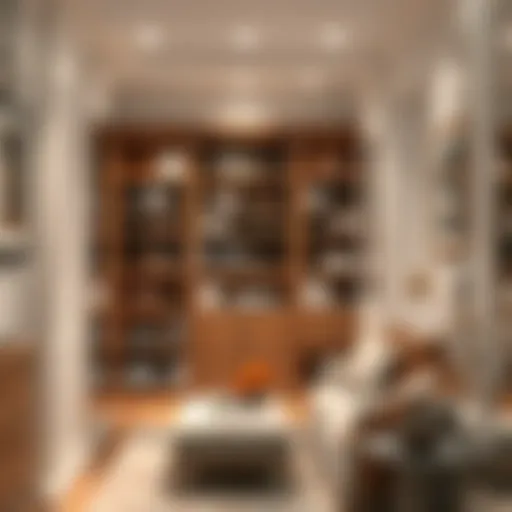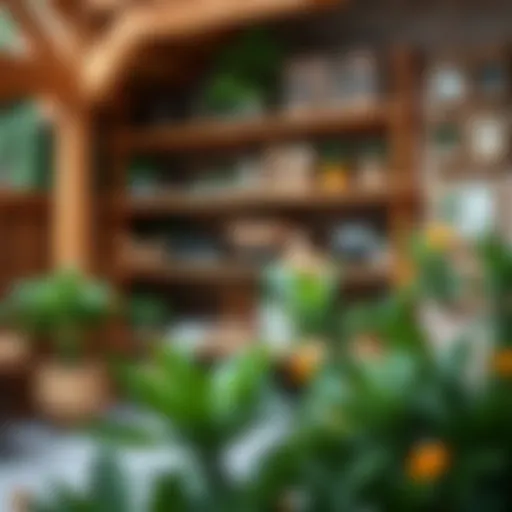The Aesthetic Appeal of Blue, Green, and Gray Rugs
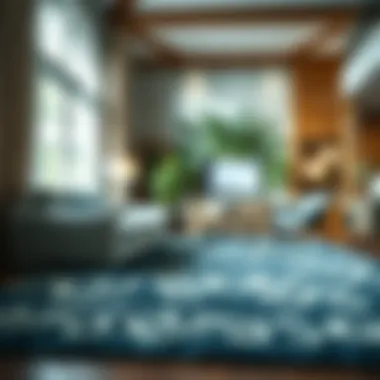
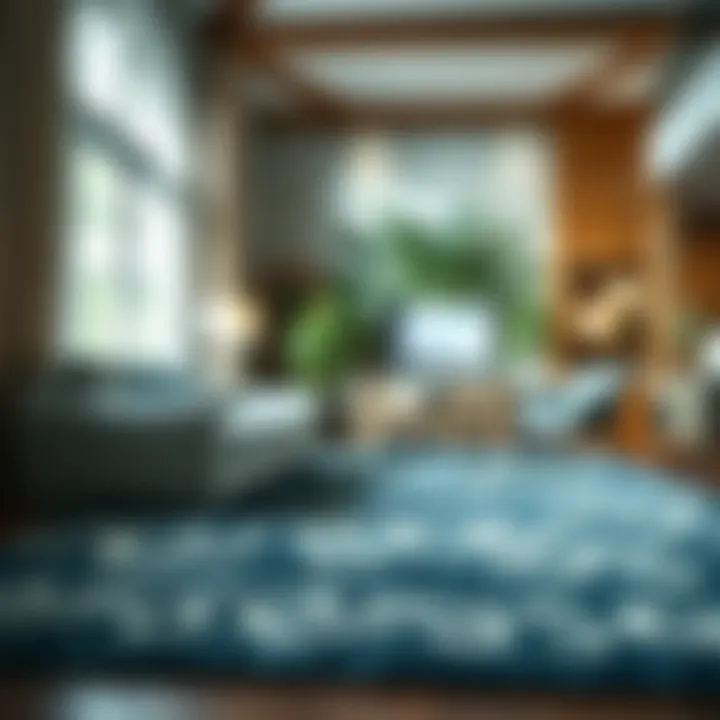
Intro
When it comes to interior design, few elements have the power to transform a space quite like an area rug. The colors blue, green, and gray hold a special significance in this realm, each bringing its own unique vibe and character. In this exploration, we will unpack how these colors interact with various design themes and the ambiance they can create. From coastal retreats to modern urban lofts, understanding their appeal can guide homeowners and designers alike in crafting spaces that are both stylish and functional.
The world of area rugs is not just about aesthetics; it’s also about making informed choices. This narrative will provide valuable insights into selecting the right piece, maintaining its beauty, and placing it effectively within your home. Join us as we dive deep into the many facets of blue, green, and gray rugs and their significant role in today's furniture trends.
Preamble to Area Rugs
Area rugs play an indispensable role in the overall aesthetic and functionality of a home. They are not just pieces of textile to cover the floor; they serve as vital elements that tie together the various aspects of interior design. From establishing a focal point in a bare room to enhancing the comfort of living areas, area rugs offer both practical benefits and opportunities for expression.
Defining Area Rugs
An area rug is defined as a large decorative rug that covers a significant portion of a floor space yet does not extend wall-to-wall. The sizes of these rugs can vary greatly but typically encompass areas ranging from five by eight feet to eight by ten feet and beyond. The styles and materials can be incredibly diverse, with options such as wool, cotton, synthetic fibers, and various weaving techniques. They can be used in different rooms, including living rooms, bedrooms, and even kitchen spaces.
In essence, area rugs are transitional objects that can bring harmony to an area. They create boundaries within open spaces, which is particularly important in modern, open-concept homes. By defining specific zones—like a cozy reading nook or a dining area—rugs help delineate functions without erecting physical barriers.
Importance in Home Decor
The importance of area rugs in home decor cannot be overstated. They are valuable tools that offer several benefits:
- Visual Cohesion: Area rugs can create a sense of unity throughout a space. A well-chosen rug can enhance the color palette of a room, making disparate elements feel related and cohesive.
- Comfort and Warmth: Rugs add a layer of comfort underfoot, especially in homes with hard surfaces like tile or hardwood. They absorb sound, making rooms feel warm and inviting.
- Style Statement: They allow homeowners to express their unique style. Whether choosing bold patterns or subtle textures, rugs can elevate the aesthetic quality of a room.
- Protection: Area rugs can help in extending the life of floor surfaces by acting as a barrier against wear and tear, spills, and scratches.
By investing in the right area rugs, homeowners not only enhance the aesthetic appeal of their spaces but also create environments that feel complete, thoughtful, and reflective of personal taste.
Understanding Color Theory in Interior Design
When it comes to designing inviting and aesthetically pleasing spaces, understanding color theory is crucial. The hues we choose can significantly affect the overall vibe of a room. This section delves into why color theory should not be an afterthought for homeowners or designers. It offers insights into the connection between colors, feelings, and design harmony.
Color isn’t just superficial; it plays a vital role in setting the tone for our living environments. For instance, hues of blue can evoke calmness, while vibrant greens often remind one of nature. Grays, on the other hand, bring sophistication and balance into the mix. Recognizing the emotional and psychological effects of these colors can guide decisions on flooring options, specifically area rugs that can harmonize well with existing decor.
Impact of Color on Mood
Colors have a mysterious way of influencing our emotions. Research shows that blue is often associated with tranquility and peace, making it an excellent choice for spaces meant for relaxation, like bedrooms or reading nooks. Imagine sinking into a plush navy area rug after a long day – it’s like a gentle hug for your tired feet.
Conversely, green brings freshness and vitality into a home. This color can reduce stress and improve overall well-being, serving as a reminder of the outdoors. An emerald green area rug can create a sense of connection to nature, even in a bustling urban apartment. The impact can be transformative, turning an ordinary room into a personal sanctuary.
Gray, often overlooked, stands out as the unsung hero in color palettes. It’s more than just neutral; it adds an element of elegance and can ground a room. Depending on the shade, it can feel cozy or cool. A light gray rug can open up a space and create an airy feel, while a charcoal option can add depth and warmth.
"The right color can breathe life into a dull space, while the wrong choice can drain energy away."
Color Combinations and Aesthetics
Pairing colors isn’t simply about selecting what looks good together; it’s about creating a cohesive narrative throughout the space. Blue, green, and gray can work in tandem to develop a visually stimulating environment. Consider a room where a deep sapphire rug complements soft olive walls; the blend strikes a balance between calmness and energy.
When it comes to combining these colors, several formulas can guide the selection process:
- Analogous Colors: Choose shades that are next to each other on the color wheel. Pairing a blues with green can create a serene ambiance.
- Complementary Colors: These are opposite each other on the color wheel. Incorporating warm accents like yellows with your cool-toned rug can add vitality.
- Monochromatic Schemes: Using varying shades of a single color can yield sophistication. A pale gray rug might pair beautifully with charcoal curtains.
In essence, a well-thought-out color scheme can elevate area rugs beyond mere decorative items; they become focal points that tie a room together. The interplay of these colors can transform atmospheres, making them feel cohesive and intentional.
In summary, understanding color theory in interior design provides a foundation for crafting engaging, personal spaces that reflect individual tastes and emotions. By effectively employing shades of blue, green, and gray, homeowners not only elevate their aesthetic options but also enhance their well-being and comfort.
Blue Area Rugs: A Dive into Tranquility
When it comes to creating a serene environment in your home, blue area rugs hold a significant position. This color has a unique ability to evoke feelings of calm and relaxation, similar to gazing at a clear sky or the tranquil surface of water. Using blue in room design, especially through area rugs, is not just an aesthetic choice; it’s a means to enhance emotional well-being.
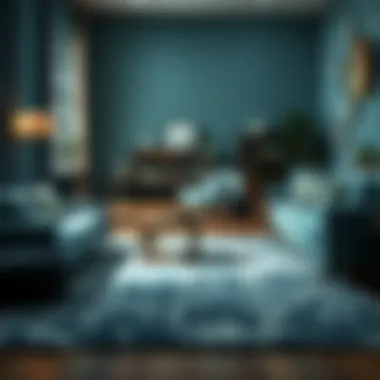
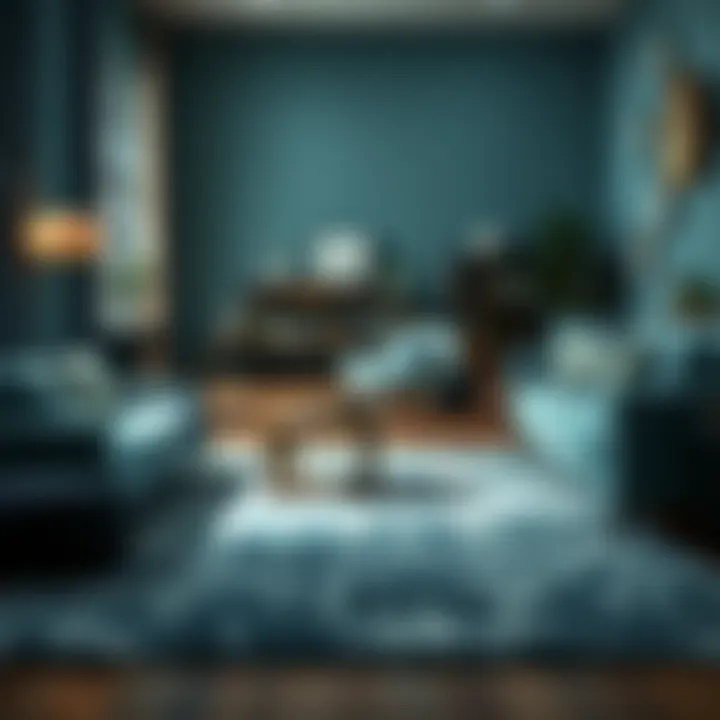
The importance of blue area rugs in this article lies not only in their color but also in the tranquil ambiance they create in various living spaces. Homeowners and designers can harness the potential of blue rugs to transform a space into a peaceful retreat. From subtle shades to bold hues, blue can influence the mood of a room profoundly. Understanding how to effectively integrate blue area rugs can significantly improve the overall feel of your interior.
Shades of Blue: From Navy to Sky
Blue isn’t just one color; it’s a spectrum of shades, each with its own unique vibe. Think of navy, which brings a depth and richness, perfect for making a bold statement or for grounding a room, while powder blue offers a lightness that can lift the spirit.
Here are some popular shades of blue and how they can be utilized:
- Navy Blue: Great for making a room feel cozy and intimate. It pairs well with light-colored furniture.
- Sky Blue: This color can open up a room, making it feel more spacious, ideal for smaller spaces or open-plan layouts.
- Teal: A beautiful combination of blue and green, this shade works wonders in modern and coastal designs.
- Turquoise: Bright and lively, turquoise can add a fun twist to playful spaces such as children's rooms or casual living areas.
Each shade of blue offers a different aesthetic appeal, and selecting the right one can greatly influence the mood and design of your home.
Ideal Spaces for Blue Rugs
Blue area rugs can seamlessly fit into various types of spaces. Their versatility makes them ideal for many rooms in a house:
- Living Rooms: Here, blue rugs can define spaces, especially in open-concept designs. Consider using a navy area rug to anchor a seating arrangement.
- Bedrooms: In bedrooms, softer blue shades can turn the area into a restful haven, encouraging relaxation and calmness at the end of the day.
- Home Offices: The presence of blue can enhance productivity; thus, it’s an excellent choice for rugs in workspaces. A light blue rug can stimulate creativity without being overwhelming.
- Bathrooms: Blue rugs can mimic the feeling of cleanliness and refreshment, akin to a water environment. They can add a touch of elegance in the bathroom while maintaining a fresh vibe.
Complementary Colors for Blue Rugs
Understanding how to pair blue area rugs with other colors can elevate your design game. Blue works well with various colors, and when combined thoughtfully, it can create a harmonious aesthetic:
- White: A classic pairing that offers a crisp and clean look. Think about how many seaside cottages employ this balance.
- Gray: Soft greys can enhance the serenity of blue, creating a modern and sophisticated atmosphere.
- Coral or Peach: For those who enjoy a bit of contrast, coral brings warmth and pops beautifully against cooler blue tones.
- Yellows: Light yellows can open up a space, giving it a sunny vibe when paired with blue.
By embracing these complementary colors, homeowners can create a layered and dynamic look that exudes both comfort and style.
"In design, color creates an emotive response; it influences our thoughts and feelings more than we realize." This statement captures the essence of why selecting the right blue area rugs can be pivotal in interior decor.
Green Area Rugs: Infusing Nature into Interiors
Incorporating green area rugs into home decor offers a refreshing way to bring the beauty of the outdoors inside. Their hues emulate the serenity of a lush landscape, acting as more than mere floor coverings; they create an inviting atmosphere while influencing the overall aesthetic of a room. Choosing green, from soft sage to vibrant emerald, can evoke a variety of moods, enhancing a homeowner's connection to nature. This section aims to explore the different shades of green, how these rugs fit various design styles, and the best practices for pairing them with existing furniture.
Exploring Various Hues of Green
Green area rugs come in a rainbow of shades, each contributing its own unique appeal to a space. For example:
- Olive Green: This muted tone offers an earthy feel, perfect for rustic or bohemian styles. It's calming yet sophisticated, making a bold statement without overwhelming the senses.
- Mint Green: Evoking freshness, mint is ideal for spaces aiming for a light and airy ambiance. It pairs well with pale blues or crisp whites, enhancing the feeling of openness.
- Dark Forest Green: For a drama-filled look, deep green can ground a space, working effectively in more traditional or luxurious settings.
Different hues of green can play off the character of a room, either blending harmoniously with other colors or acting as a bold contrast, so selection is paramount.
"A well-chosen green rug does not only beautify a room but also nurtures the soul, bringing life to a static environment."
Green Rugs for Different Design Styles
Understanding your design style can guide your selection of a green rug. Whether you lean towards the clean lines of modern minimalism or the warmth of mid-century modern, there's a green rug that can complement your vision:
- Contemporary: Opt for a geometric pattern in bold shades like moss or chartreuse which add depth without cluttering the space.
- Traditional: Vintage prints in botanical motifs can imbue a classic feel, tying together disparate elements in a room.
- Scandinavian: Soft, muted greens in natural fibers like jute or wool work great, underscoring the emphasis on simplicity and sustainability inherent in Nordic design.
These styles showcase how versatile green rugs can be, fitting seamlessly into a variety of home aesthetics.
Pairing Green Rugs with Furniture
Selecting the right furniture to complement a green area rug can be a balancing act. Here are some pointers:
- Neutral Furniture: Aim for beige, gray, or white furniture to allow the green rug to steal the show. This encourages an open, uncluttered atmosphere.
- Wood Accents: Natural wood tones can enhance the organic feel initiated by green rugs, offering warmth that balances the coolness of the color.
- Metallic Touches: Incorporating gold or brass accents can provide a striking contrast, adding an element of glam that’s perfect for modern or eclectic interiors.
When designing, consider the overall scheme. A green rug can be a bold anchor, allowing other elements to harmonize around it, be they contemporary artworks, vintage pieces, or sleek modern furniture.
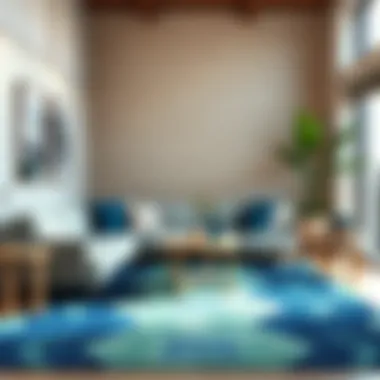
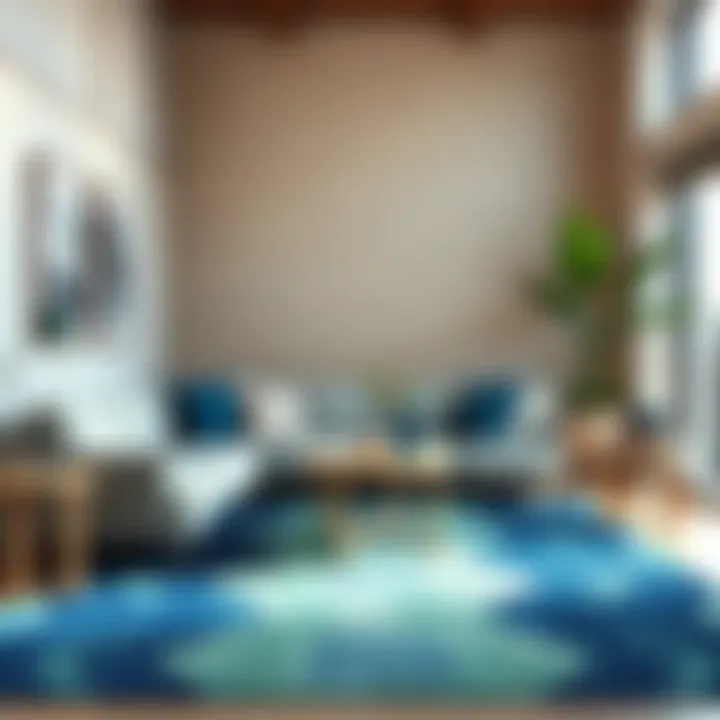
By selecting the right hue, style, and complementary furniture, one can maximize the appeal that green area rugs provide.
Keeping these aspects in mind can elevate home decor, transforming any space into a natural retreat.
Gray Area Rugs: The Neutral Option
Gray area rugs have become a go-to choice for many homeowners and designers looking to create stylized environments that still promote a sense of calm. These rugs provide a neutral backdrop that allows other decor elements, such as furniture and artwork, to take center stage. However, don’t think of gray as just a bland option— it offers a spectrum of shades and textures that can significantly affect the overall ambiance of a room.
When integrating gray rugs into your decor, consider how versatile they truly are. They can seamlessly transition from traditional to modern spaces, acting as an adaptable canvas for your design vision. Furthermore, gray area rugs are often found in various materials, from soft, thick fibers to sleek, flat weaves, accommodating different preferences and lifestyles. This inherent flexibility is the reason why gray has solidified itself as a leading color choice in interior design.
Variations of Gray in Textiles
Diving into the variations of gray available in textiles reveals an exciting array of choices. You have everything from warm grays that possess subtle brown undertones, to cooler, bluish grays that can impart a more serene and sophisticated look.
- Warm Grays: Often seen in textiles like wool or cotton, they carry an inviting and cozy appeal. These softer grays can create an intimate setting in living or reading areas.
- Cool Grays: Typically utilized in modern and minimalist designs, cool gray rugs can enhance a sense of order and simplicity. They work beautifully in spaces with sharp lines and geometric shapes.
- Charcoal and Slate: Darker gray options can add a dramatic flair to any space—perfect for modern interiors that crave a bold statement without overwhelming other elements.
These variations not only contribute to the overall design but also play a role in how one interacts with the space. Choosing the right shade can help an area feel more expansive or more grounded, depending on your needs.
Versatility of Gray in Different Layouts
One of the most significant advantages of gray area rugs is their versatility concerning layouts. They can fit into nearly any room configuration without clashing with other elements. Consider the following aspects:
- Living Room: A plush gray rug serves as an ideal focal point in this space, allowing other vibrant colors or patterns in furniture and decor to shine.
- Dining Room: In open-plan living areas, a gray rug can help delineate the dining space while still tying into the overall theme of the home.
- Bedroom: Soft gray rugs provide comfort and warmth underfoot, enhancing the cozy feel of a retreat.
Gray rugs can be used in layered styling too. For instance, placing a larger gray rug under a smaller, more colorful rug can create depth and interest, turning a simple area into a dynamic visual experience.
Combining Gray with Other Colors
Combining gray with other colors can yield breathtaking results, whether it is complementary or contrasting hues. Given its neutral nature, gray pairs exceptionally well with various colors, enhancing spaces without overpowering other decor choices. Here are some combinations worth exploring:
- Blue and Gray: This duo can reflect sophistication and calmness. A blue and gray area rug can anchor a room, making it feel unified and intentional.
- Earth Tones: Gray's grounding nature, especially alongside various browns and greens, promotes a tranquil and organic vibe. This pairing is especially appealing in nature-inspired designs.
- Bold Colors: For a more daring approach, combine gray with bright yellows, reds, or greens to create striking contrasts that invigorate a room.
Ultimately, gray area rugs stand as a testament to the profound impact that a simple color can have on your home. Their adaptability and range illustrate that neutral does not have to mean boring; it can be an elegant solution that forms the backbone of extraordinary design.
Choosing the Right Area Rug for Your Space
Selecting the right area rug is like finding the perfect piece of a puzzle—it completes the picture of your room. An area rug can enhance the visual appeal of your space, anchoring furniture and creating a defined area within a larger room. Whether you’re a seasoned decorator or a newbie at home styling, understanding how to choose the right rug is essential for achieving a harmonious and aesthetically pleasing environment.
A well-chosen area rug can strike a balance between style and functionality, blending seamlessly into the decor while also offering comfort underfoot. With the abundance of options available today—various sizes, colors, patterns, and materials—making an informed choice can be a daunting task. Thus, it’s crucial to assess key factors such as room size, layout, material, and texture to ensure your selection enhances both the beauty and practicality of your living space.
Assessing Room Size and Layout
The dimensions and design of your room are pivotal when selecting an area rug. A magnificent rug might seem irresistible at first glance, but if it doesn’t fit with your layout or scale, it can easily overpower—or shrink—the space. Here are some considerations:
- Measure the space: Always start with measurements. Knowing the room's length and width will guide you in choosing a rug size that works proportionately.
- Define spaces: In open-concept homes, area rugs can help delineate separate areas like living rooms and dining spaces. Opt for larger rugs to create the illusion of a unified area.
- Furniture placement: Visualize how your furniture will sit on the rug. Ideally, larger furniture should rest on the rug to create a cohesive look, while smaller furniture can continue the design.
These considerations encourage a functional aesthetic. A rug that aligns with your room's dimensions can create comfort, cohesively tying together furnishings, colors, and textures.
Material Considerations for Durability
The material of your chosen area rug greatly impacts its durability and maintenance needs. Different fibers possess unique characteristics, making some suitable for high-traffic areas while others excel in appearance. Here’s a brief rundown on popular materials:
- Wool: Known for its durability and resilience, wool rugs are a classic choice. They stand up well against wear and tear, making them ideal for living rooms or hallways.
- Polyester: If allergy concerns come into play, polyester rugs are often more hypoallergenic. They are also easy to clean, providing a resilient choice for households with pets.
- Cotton: Lightweight and often washable, cotton rugs suit kitchens and bathrooms well. However, they may not stand up to heavy foot traffic as well as wool.
- Jute/Sisal: These natural fibers offer a rustic look and are eco-friendly, although cleaning can be tricky because they absorb moisture.
Choosing the right material involves balancing durability against aesthetic needs. A rug that complements your space while being easy to maintain can save you time and energy in the long run.
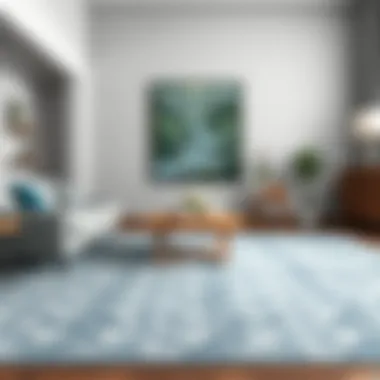
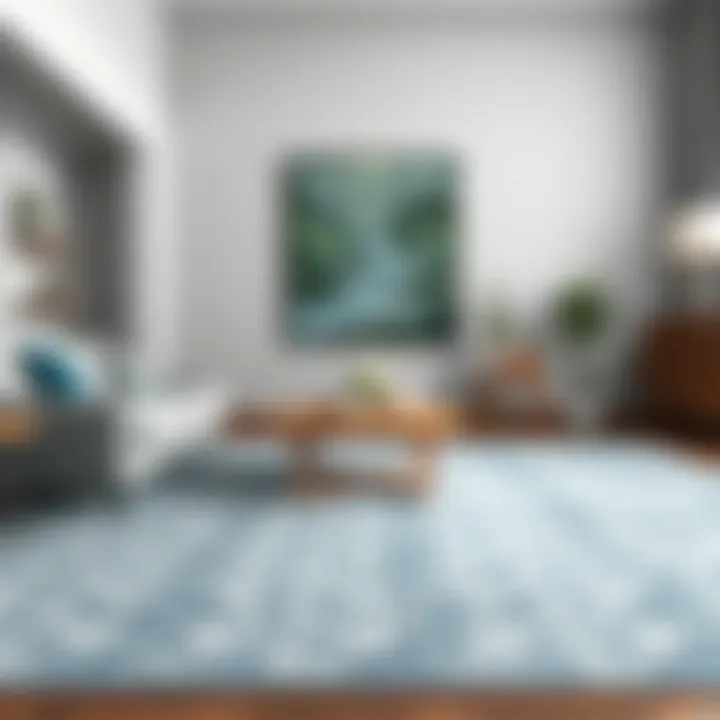
Texture and Its Role in Design
Texture plays a significant role in the visual and tactile experience of an area rug. It can evoke emotions and enhance the room’s atmosphere. Consider this:
- Visual interest: Rugs with varying textures can add layers to your design scheme. A shag rug might feel cozy, while a flat-weave might convey modern sophistication.
- Comfort: A soft, plush rug can offer a comforting feel underfoot, which is especially cozy in bedrooms and family areas. A coarser texture can lend an organic vibe, suitable for rustic styles.
- Contrast: Pairing a smooth, sleek rug with plush furniture can create a delightful contrast, while textured rugs against a smooth floor can add depth.
Texture is not just about the physical feel but also the aesthetic interaction it creates within your decor. A well-chosen texture can create balance among the various elements in your space, whether you favor minimalist or eclectic styles.
"A thoughtfully chosen area rug is more than a piece of decor—it's an integral part of your home’s identity."
For personalized advice, connect with experts or browse dedicated forums like Reddit's Home Decor for insights and trends.
Maintaining Your Area Rug
Maintaining an area rug is not just a chore; it’s an essential aspect of ensuring that your investment serves you well over time. Regular care can significantly extend the life of your rug, keeping it looking fresh and vibrant. Area rugs are often the focal point of a room, and their condition can impact the overall aesthetic of your home. Taking the time to care for them means preserving their beauty and functionality.
Routine Cleaning Practices
To keep your area rugs in top shape, establish a regular cleaning routine. Sweeping or vacuuming your rug once a week can prevent dirt and dust build-up. For those with pets or children, you might want to increase the frequency. Here are some practical steps to consider:
- Vacuum Regularly: Use a vacuum cleaner with a beater bar or a suction-only vacuum for rugs. This helps lift dirt that may be embedded in the fibers.
- Shake It Out: If your rug is small enough, take it outside and give it a good shake. This will remove some of the debris that a vacuum can miss.
- Spot Clean: Whenever you notice a stain, attend to it immediately. Blot the area gently with a clean cloth instead of rubbing, which can damage the fibers.
Dealing with Stains and Spills
Accidents happen, and knowing how to respond quickly can save your rug from permanent damage. Here are crucial steps for tackling stains on your area rugs:
- Act Quickly: Time is of the essence. The quicker you treat a stain, the better your chances of removing it entirely.
- Identify the Stain Type: Different stains require different approaches. For example, water-based stains can often be treated with soap and water, while oil-based stains demand special handling.
- Use Mild Solutions: A mixture of mild dish soap and water can often do the trick for many common stains. Test any cleaning solution on a small, inconspicuous area first to ensure no discoloration occurs.
- Blot, Don't Rub: Blotting helps lift the stain without damaging the fibers. Rinse the area with clean water after treating the stain and blot dry.
"Remember, a well-maintained rug can enhance your home’s charm and comfort."
Professional Cleaning vs. DIY Methods
There’s a continuous debate about whether to clean rugs yourself or hire professionals. Each method has its merits, and what you choose depends on various factors like the type and size of the rug, as well as your budget.
- Professional Cleaning: For large area rugs, particularly those made from delicate fibers or with intricate designs, it might be best to hire a professional cleaner. They often have access to specialized equipment and cleaning solutions that can provide a deep clean without risking damage. Look for certified cleaners with experience in textile care.
- DIY Cleaning: If your rug is simpler and you’re comfortable getting your hands dirty, DIY methods can be effective. Steam cleaning, or using a carpet shampooer, can work wonders for less delicate materials. Just ensure you’re following the guidelines for cleaning any specific type of rug.
Ultimately, consider the condition of your rug. A high-quality, costly piece might warrant professional attention, while a more affordable or durable rug might be perfectly fine with a good DIY scrub.
In maintaining area rugs, you can preserve their aesthetic appeal and functionality. This regular attention ensures that your rugs remain a source of beauty and comfort in your home.
The Psychological Effects of Area Rugs in Home Environments
The ambiance of a home is not just about aesthetics; it deeply influences how we feel and interact in our space. Area rugs, whether blue, green, or gray, play a significant role in shaping this atmosphere. Their colors and textures can evoke different emotions, making them a powerful tool in interior design.
Creating Comfort through Texture and Color
Texture is a key player when it comes to comfort in home environments. A plush, shaggy rug underfoot can create a sense of warmth and coziness, almost like a gentle embrace. It encourages relaxation, drawing you in after a long day, while adding a tactile richness to a room. Color also enhances this comfort. A soft blue area rug might cast a calming influence, mimicking the serene sky, promoting feelings of tranquility. Conversely, a vibrant green can invigorate the senses, reminding one of lush gardens and the freshness of nature.
However, it’s not just about feel and sight; the psychological impact can extend far beyond immediate comfort. The hues selected often speak to individual personalities. A homeowner who chooses soft pastels likely seeks serenity, while bold, bright colors might reflect an outgoing nature.
Epilogue
The conclusion serves as a crucial component of this article, tying together all the various threads explored throughout the discussion on area rugs, specifically those in blue, green, and gray. By emphasizing the aesthetic appeal of these colors, the conclusion underscores their significance in not just decor, but in creating atmospheres that resonate with our moods and lifestyles. Homeowners, designers, and DIY enthusiasts all stand to benefit from understanding how these hues interact with their environments, ultimately enhancing their spaces in meaningful ways.
Recapping our key insights, we've seen how the tranquil nature of blue area rugs can evoke serenity, while green rugs bring the essence of nature indoors. Gray, as the neutral player, offers versatility and sophistication, complementing a wide array of design themes. Each color has its unique influence on warmth and comfort, creating spaces that not only look good but feel good mentally and emotionally.
It is essential to consider not just the visual aspects of these rugs but also their functional roles. From routines in cleaning to understanding the wear and tear based on material, each detail has been highlighted to provide a holistic view of rug ownership. The right area rug does not just fill space; it shapes experiences, supports activities, and adds depth to a room’s character.
"Area rugs are more than just decorative pieces; they are the foundation on which comfort and style are built in any home."
In the final thoughts regarding rug selection, it becomes evident that the decision-making process should align with personal aesthetics and the specific needs of a space. Factors like size, material, texture, and color dynamics come into play when choosing the perfect piece. Each choice influences not only the room’s appearance but also its overall vibe and functionality.
To sum up, the article not only explored the rich aesthetic choices of blue, green, and gray area rugs but also encouraged readers to look beyond surface beauty. With an informed approach to selection and placement, anyone can craft a space that is engaging, harmonious, and reflective of their individual style.



